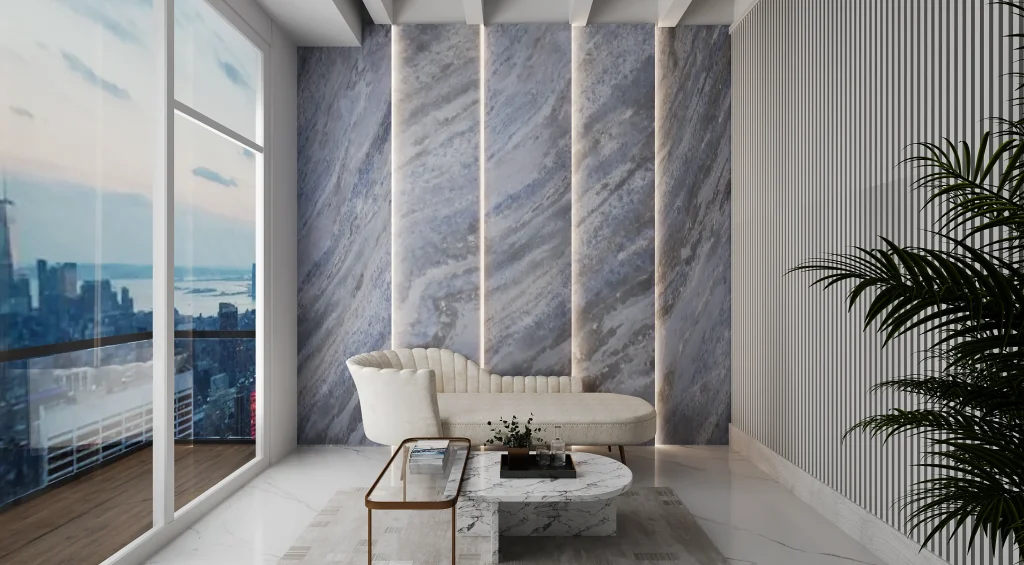When it comes to interior design, the choice of material plays a key role in elevating a space in terms of both aesthetically and functionally. From countertops to flooring to decorative features, choosing the right surfacing materials is critical to creating a perfect ambiance. Calcite stands out as a one-of-a-kind stone to decorate your environment, offering an exemplary blend of natural beauty, elegance, and versatility. In this article, we will look at the many faces of calcite surfaces.
What are Calcite Surfaces?
We must not confuse calcite rock with calcite mineral. Calcite surfaces are primarily made of the mineral calcite, which is made through prolonged precipitation of calcium carbonate (CaCO3) from water. Around the natural water bodies, calcite-rich sediment accumulates and forms multiple layers over decades. As a result of constant pressure from the upper layers, the lower layers of calcite start cementing together into a solid calcite rock. Moreover, calcite can transform into both marble and limestone when it is exposed to certain circumstances.
Variety of Colors in Calcite Surfaces
What makes calcite surfaces stand out in the crowd of granites and marbles is their swoon-worthy range of colors, from translucent whites to vivacious oranges and blues. Calcite slabs are known for their eccentric palette in a captivating display of hues highlighted by soft veining, such as Caraibica Blue, attributed to impurities present during the formation of the stone. Interestingly, some dolomites come with the distinctive crystalline appearance of calcite due to the presence of the mineral, for instance, Cambrian White, and Diamante. However, the timeless appeal and dazzling beauty of calcite surfaces can add a touch of luxury to any space.
Is Calcite Translucent?
Interior designers are drawn to the crystalline luster of calcite that can infuse any space with warmth, elegance, and sparkle. Translucency is one of the most attractive features of calcite surfaces, allowing light to pass through the stone and emit an enchanting glow. Backlit translucent or semi-translucent calcite countertops or backsplashes can brighten up any setting with a luminous radiance, making the space look more warm and inviting. The beautiful interplay of light adds a different dimension to any decor style, transforming it into a magical aesthetic. Interior designers often use this unique property of calcite slabs to create accent features that serve as a focal point of luxurious residential and commercial spaces. Check out our stunning translucent White Calcite surface that can be a great addition for backlighting.
How Durable Is Calcite Surfaces?
Beyond their captivating aesthetic, calcite surfaces offer functional benefits that make them perfect for a diverse range of applications. In spite of being relatively soft compared to other natural stones, such as quartzite or granite, calcite is a durable surface when sealed and maintained properly. It can withstand daily wear and tear if you practice routine cleaning and maintenance, making calcite a perfect choice for table tops, countertops, and other high-traffic areas of your house. In addition to this, calcite slabs offer exceptional heat resistance, which makes them suitable for fireplace and kitchen applications.
Calcite ranks 3 on the Mohs scale of hardness, which means it can be scratched easily. However, calcite surfaces are often processed and treated with resins, or other materials to make them resilient against staining, scratching, or chipping.
Caring for Calcite Countertops and Floors
It is essential to practice proper care and maintenance for your calcite surfaces in order to ensure their longevity and preserve their timeless elegance. Calcite being a porous material can absorb liquids quickly, leaving the surface stained, which is why you should promptly wipe up spills or splashes with a soft cloth. Make sure to regularly clean the stone with water and pH-neutral cleaner.
Calcite can react to acidic substances, resulting in dulled spots, called etches. Hence, avoid acidic cleaning products and be mindful while handling lemon juice, vinegar, or other acid-based food products. Also, avoid abrasive cleaners on the surface, as it might leave scratches. Consider periodic sealing of your calcite surfaces to protect them against stains and scratches.
Versatile Applications
Calcite has found its way into the world of interior design thanks to its exceptional look and crystalline luster. Calcite surfaces can grace your place in the form of countertops, flooring, backsplashes, wall cladding, fireplace surrounds, and other decorative accents. However, it might not be suitable for outdoors given that it can get affected easily by environmental impacts.
At Ultra Stones, Explore an exclusive inventory of over 600 colors in both natural and engineered stones, including Calcite in New York and Pennsylvania at https://ultrastones.com


